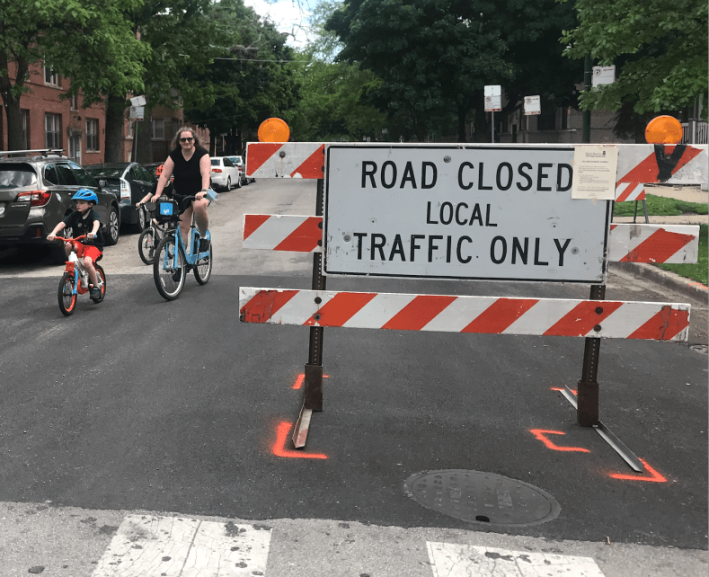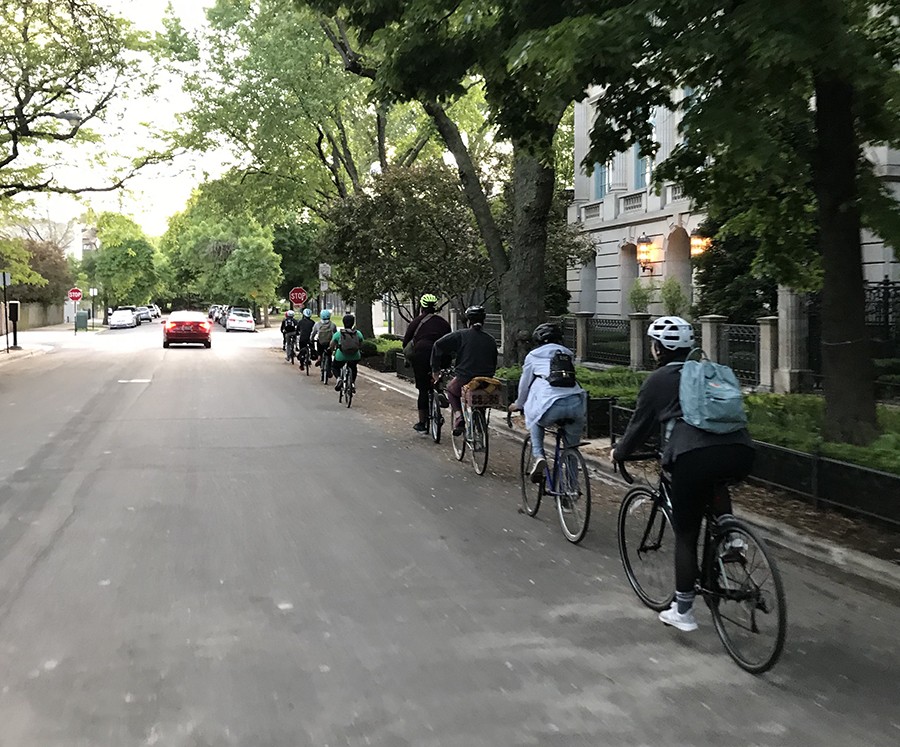Update 7/1/20, 4:30 PM: Following a call this afternoon with CDOT, the 43rd Ward told Streetsblog that, due to a water main project on Dickens east of Clark Street, as well as curbside food pickups at R.J. Grunt's restaurant at Dickens and Lincoln Park West, it has been decided that the Slow Street will end at Clark, not Stockton. The article has been updated accordingly. Installation of the Slow Street is slated to begin on Tuesday. The portion of the route on a path through Oz Park will feature special signs depicting an adult and a child holding hands, wearing masks, to remind cyclists to yield to park users on foot.
Lincoln Park's many affluent and/or politically-connected residents tend to take their Not In My Back Yard-style opposition to good projects very seriously.
The Chicago Department of Transportation's fairly innocuous proposal to install a traffic-calmed "neighborhood greenway" on Dickens Avenue between the Lincoln Park green space and Clybourn Avenue, first presented in May 2019, has faced fierce, organized resistance from some neighbors. The project would include a contraflow bike lane to allow eastbound cycling on the one-way westbound street, and would also feature a lower 20 mph speed limit, sidewalk extensions, speed humps, and raised crosswalks to calm motorized traffic and make walking safer and easier.

However, a vocal minority of residents have argued that more cyclists on Dickens would be a menace to public safety. Some of them raised the specter of “fixie kids” from other neighborhoods riding down Dickens, especially if the Bloomingdale Trail is extended east across the Chicago River as part of the nearby Lincoln Yards development.
The Dickens opponents slick, anonymous mailings against the city’s Dickens Avenue neighborhood greenway proposal, somehow getting access to the names and mailing address of dozens, maybe hundreds, of residents along the corridor. They also launched a Friends of Dickens NIMBY website, making a series of spurious claims about how the safety improvements would endanger residents.
It seemed like the Dickens NIMBYs were rendered irrelevant last August, when 100-plus people packed the auditorium of Lincoln Park High last night for a community meeting on the family-friendly bikeway — including plenty of children -- and there seemed to be a clear majority of residents who support the project. This was evidenced by dozens of public comments praising the initiative, hundreds of petition signatures endorsing it, and scores of attendees wearing green to show their support.

However, there has been no obvious movement on the project since then. The Chicago Department of Transportation did not provide an update when Streetsblog asked for one last week.
The Dickens Greenway opponents have continued to tireless lobby 43rd Ward alderman Michele Smith, going as far to hire a publicist, Anne-Marie St. Germaine of Terrace Strategies, to promote their cause. Ward staffers declined to comment on the issue earlier this week. St. Germaine didn't respond to an interview request.
However, Alderman Smith announced great news announced in her newsletter today. CDOT will be implementing a temporary Slow Street route on Dickens, basically on the same stretch as the area proposed for the proposed permanent greenway, from Clark Street, a block west of Lincoln Park, to Racine Avenue, a block or two east of Clybourn.
In the map below, red lines show proposed Slow Streets, orange are routes approved by aldermen, and green are installed Slow Streets.
As Streetsblog Chicago readers know, Slow Streets (CDOT is calling them "Shared Streets") are side-streets where through traffic is banned and speeding is discouraged with barricades and traffic barrels, to make room in the street for safe, socially-distanced walking, running, and biking. Parking, deliveries, and pickups and drop-offs are still permitted on these corridors. Doing a Slow Street on Dickens is a great way to test out the neighborhood greenway concept without making permanent infrastructure changes.

"We all know that it is hard to maintain social distancing while walking down sidewalks," Smith wrote. "The city has been interested in assigning a few streets throughout the neighborhoods to allow freer and easier movement of walkers, families, cyclists, runners and the like in our neighborhoods." Smith noted that the Slow Street treatments have been successful on roadways like Leland Avenue in Lincoln Square, which was so popular that it was recently extended west another half-mile, and Wabanasia Avenue near the Bloomingdale Trail.
The Dickens Slow Street will initially be installed for 30 days, during whichCDOT will gather community input, collect data, conduct observations, and determine whether the program should be extended an additional 30 days or not. "While we expect that some are nervous about this experiment, we encourage residents to participate and, after the street is launched, to please give feedback to us and the city," Smith wrote.
The ward did not immediately provide a timetable for Slow Street installation, but a staffer said there should be an update soon.
Kudos to Alderman Smith and CDOT for devising this clever, diplomatic way to pilot safe walk/bike infrastructure on Dickens. While it's likely that many of the Dickens Greenway NIMBYs aren't pleased by this news, if this Slow Street is anything like the other ones across town, other residents will be so happy with it that they'll lobby the alderman even harder to make Dickens a safe, walkable, bikeable street on a permanent basis by following through with the neighborhood greenway plan.




